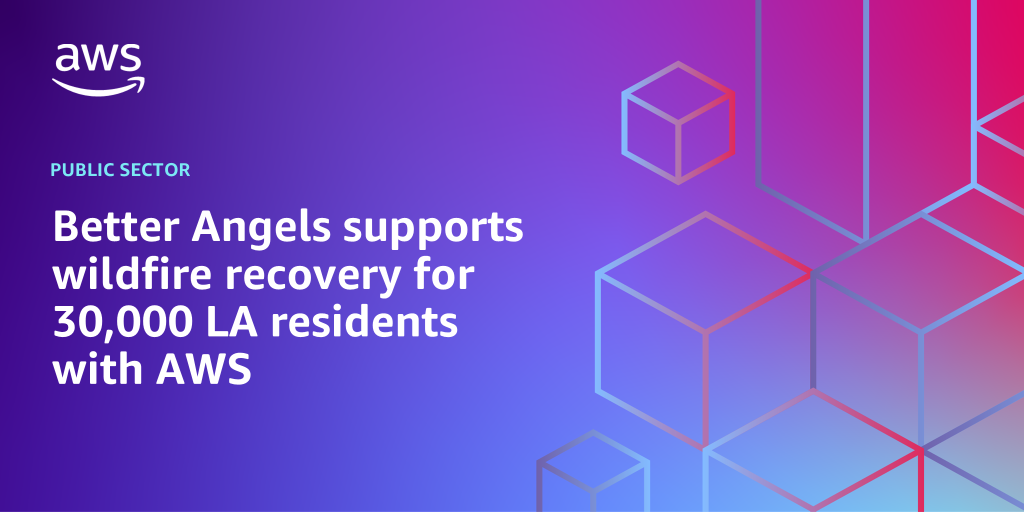AWS Public Sector Blog
Category: Disaster Response
Better Angels supports wildfire recovery for 30,000 LA residents with AWS
For the thousands of residents displaced or impacted in Los Angeles, navigating resource applications, aid forms, and ever-changing information is a daunting task that can delay them from getting back on their feet. Read this post to learn how Better Angels launched the LA Disaster Relief Navigator—in partnership with Imagine LA—to transform disaster recovery from a reactive process into a proactive, community-informed response. Using the agility and scale of AWS, Better Angels built a resilient digital platform that generated approximately 6,000 personalized recovery plans, directly reaching nearly 30,000 people in need.
Proactive strategies for cyber resilience and business continuity on AWS
AWS recommends that organizations prepare to recover workloads in case of cybersecurity incidents or business continuity events such as technical or natural disasters. In this post, we offer guidance and strategies for public sector organizations to use AWS infrastructure to operate resilient systems in the cloud.
Modernizing mission-critical Oracle E-Business Suite on AWS: A success story in migration and optimization
In this blog, we discuss how government agencies can evaluate and implement AWS alternatives to traditional Oracle Real Application Clusters (RAC) deployments while maintaining mission-critical availability.
California Credit Union enhances disaster recovery and backup of Fiserv DNA core banking system on AWS
California Credit Union successfully used AWS to enhance its disaster recovery and backup capabilities for its core banking system, Fiserv DNA. This post explores how the credit union overcame challenges, improved its resilience, and set the stage for future innovations in financial services.
Establishing a robust cloud platform and operational model through the CCoE
This post is part three of a four-part series that addresses how a Cloud Center of Excellence (CCoE) can be a viable solution to address the challenges of digital transformation. In this post, we address the three technical perspectives of the Amazon Web Services Cloud Adoption Framework (AWS CAF). While the business, organizational, and governance perspectives of the AWS CAF are crucial, the CCoE must also focus on the technical capabilities required to build and operate a cloud environment that meets the organization’s needs.
Seattle University’s 8-year cloud journey: Key lessons, wins, and a new path forward
Founded in 1891, Seattle University is one of 28 Jesuit universities in the US. Located in the heart of Seattle, Washington, steps away from the Amazon Web Services (AWS) headquarters, Seattle University has long focused on innovation and excellence in education. That’s why, when a critical application was reaching end of life in 2016, the university saw an opportunity to completely transform its IT landscape. Working closely with AWS, Seattle University has now migrated more than 50 percent of its applications to the AWS Cloud and is actively migrating the remaining 50 percent.
Five need-to-know facts about using the AWS Cloud for K12 cyber-resiliency
K12 leaders need tangible solutions and tactics for improving their school’s or district’s cyber-resilience in the coming school year, and Amazon Web Services (AWS) is committed to supporting schools and districts as they enhance the cybersecurity of their networks. Recently, AWS joined the White House, the Department of Homeland Security, and the Department of Education—among other leaders in the government and education community—to commit to improving the cybersecurity resilience of K12 education. As part of this commitment, AWS created the K12 Cyber Grant Program, offering up to $20 million in AWS Promotional Credits to both new and existing K12 customers.
Strengthening public safety collaboration with AWS Wickr and the Android Team Awareness Kit
For public safety agencies, secure collaboration and situational awareness are essential to preparedness and response. First responders need secure, uninterrupted communication to help them get oriented quickly and support complex coordination efforts. This post highlights how Amazon Web Services (AWS) secure communication service AWS Wickr integrates with the Android Team Awareness Kit (ATAK) to enhance the efficiency of emergency response with a user-friendly, map-based solution that expands the common operating picture and strengthens cross-team collaboration.
Disaster response and risk management using PNNL’s Aether framework on AWS
The Pacific Northwest National Laboratory (PNNL) developed Aether as a reusable framework for sharing data and analytics with sponsors and stakeholders. Aether is a mature cloud-centered framework designed using Amazon Web Services (AWS) serverless services to provide a cost-effective and reliable environment for a dozen projects currently deployed with the framework. Read this post to learn more about how Aether’s serverless-first approach is enabling disaster response and risk management.
How to detect wildfire smoke using Amazon Rekognition
Since wildfires can double in size and intensity every three to five minutes, early detection and reduced response times are essential. Cloud technologies, including artificial intelligence (AI) and machine learning (ML), can help with this. Learn a high-level architecture to create a solution with AWS that uses AI to identify and classify wildfire smoke imagery and then rapidly alert and inform first responders about the location and condition of a fire incident.









